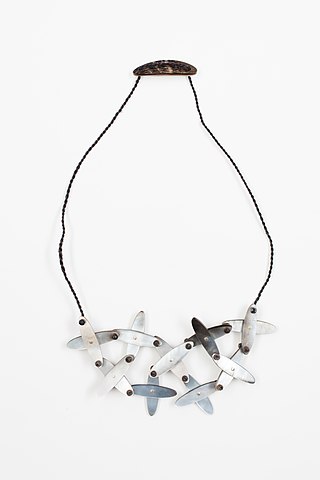Related Research Articles

The Museum of New Zealand Te Papa Tongarewa is New Zealand's national museum and is located in Wellington. Usually known as Te Papa, it opened in 1998 after the merging of the National Museum of New Zealand and the National Art Gallery. An average of more than 1.5 million people visit every year, making it the 26th-most-visited art gallery in the world. Te Papa operates under a bicultural philosophy, and emphasises the living stories behind its cultural treasures.

Leonard Ramsay Castle was a New Zealand potter.
Ann Verdcourt was a New Zealand artist. She emigrated to New Zealand with her husband, ceramic artist John Lawrence, in 1965.

Ian Barry Brickell was a New Zealand potter, writer, conservationist and founder of Driving Creek Railway.

Alan Chris Preston is a New Zealand jeweller. His work has been exhibited widely in New Zealand and internationally, and is held in major public collections in New Zealand.
Joe Sheehan is a stone artist and jeweller who works primarily in pounamu.
Warwick Stephen Freeman is a New Zealand jeweller.
Wi Te Tau Pirika Taepa is a significant figure in contemporary New Zealand ceramics, and a leading figure in contemporary Māori clay art.
Christine Lynn Boswijk is a New Zealand ceramicist. Her works are held in institutions both in New Zealand and internationally including in the Museum of New Zealand Te Papa Tongarewa, the Dowse Art Museum, the Christchurch Art Gallery, the Suter Art Gallery, the Museum of Taipei and the Aberystwyth University ceramics collection.
Chester Nealie is a New Zealand-born potter and teacher. In 1991 he moved to Australia.
James Robson "Roy" Cowan was a New Zealand potter, illustrator, and printmaker. His wife Juliet Peter was also a New Zealand potter, printmaker, and sculptor.

New Vision Gallery was a contemporary craft and art gallery operating in Auckland, New Zealand in the 1950s, 1960s and 1970s.
Paerau Corneal is a New Zealand ceramicist of Tūwharetoa and Te Āti Haunui-a-Paparangi descent.
Kohai Grace is a New Zealand weaver. Her iwi are Ngāti Toa Rangatira, Ngāti Porou, Te Āti Awa and Ngāti Raukawa.
James Mack was a curator, director, advisor and arts advocate in New Zealand and the Pacific.
This is a timeline of the feminist art movement in New Zealand. It lists important figures, collectives, publications, exhibitions and moments that have contributed to discussion and development of the movement. For the indigenous Māori population, the emergence of the feminist art movement broadly coincided with the emergence of Māori Renaissance.

Judith Ann Darragh is a New Zealand artist who uses found objects to create sculptural assemblages. She has also worked in paint and film. Darragh is represented in a number of public collections in New Zealand. In 2004, The Museum of New Zealand Te Papa Tongarewa held a major retrospective of her work titled Judy Darragh: So... You Made It?
Annie Bonza is a New Zealand fashion designer and a pioneer of boutique fashion. Her signature 'doodle' style consists of braiding, ribbon, beading, embroidery and hand painting clothing with Māori and Polynesia influences. Her work has been exhibited at Te Papa and has won awards at the Benson & Hedges Fashion Design Awards in 1971 and 1989.
Susan Skerman is a New Zealand artist.
Charles Eldon Fayne Robinson is a New Zealand Māori artist specialising in carving. Robinson has contributed to the carving of buildings on many marae in New Zealand as well as exhibiting his art in galleries and museums.
References
- ↑ Lloyd-Jenkins, Douglas; Hammond, Lucy (31 October 2014). "Crafts and applied arts - Craft in the 1990s". Te Ara - the Encyclopedia of New Zealand. Retrieved 24 January 2015.
- ↑ The Robert MccDougall Art Gallery Bulletin No. 96 June/July 1995 Archived 2008-10-16 at the Wayback Machine
- ↑ Lloyd-Jenkins, Douglas; Hammond, Lucy (10 October 2014). "Crafts and applied arts - Craft in the 1990s". Te Ara - the Encyclopedia of New Zealand. Retrieved 24 January 2015.